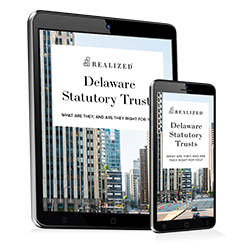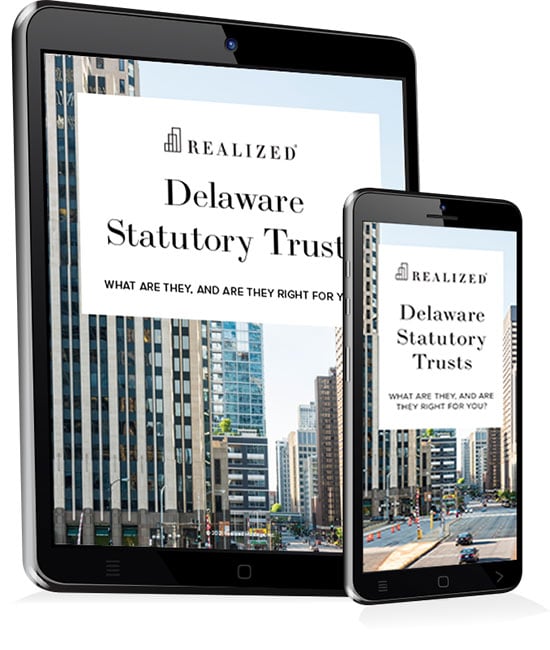
It should come as no surprise that Delaware Statutory Trusts (DSTs) carry many of the same risks as a direct property investment. After all, the underlying asset driving the investment's performance is some type of real estate asset. From illiquidity to macroeconomic risks, such as rising interest rates, DSTs are exposed to various similar factors that may spell trouble for any real estate investment.
Unfortunately, due to their structure, DSTs are subject to further risks that may not exist in direct property or REIT investments. Because they are tax-heavy, financial products, DSTs are exposed to a variety of additional forces that include regulatory and execution risk, as well as financial risk due to the fees that are baked into most DST offerings.
This article will explore the various risks and fees that DSTs are subject to and the impact that they may have on an investment. Although DSTs are costly, there are several misconceptions about the price of investing in a direct property versus a DST that this article will explore as well.
DST Risks
In a prior article we wrote titled “Disadvantages of Delaware Statutory Trust (DST) 1031 Exchange Replacement Properties”, we discuss several risks associated with owning a beneficial interest in a DST: illiquidity, lack of control, and capital restrictions. Although important and perhaps the most evident to new investors, one must not forget other key risks involved:
- Macroeconomic Risk: As with any investment in real property, rising interest rates and the health of the U.S. economy play a role in determining how the property performs. While increasingly expensive debt can have a downward pressure on returns, recessionary periods may affect property occupancy rates and the ability to find a willing buyer when it comes time to sell.
- Regulatory Risk: Because DSTs are tax-driven investments, they are subject to various regulatory constraints from the IRS. Executing a smooth exchange, while not violating any of the “7 Deadly Sins” of a 1031 exchange, is a risky endeavor and takes sufficient planning to ensure that you don’t lose the benefits of conducting an exchange. In addition, tax laws and regulations are constantly being debated and amended by Congress, with 1031 exchanges recently at the top of this list.
President Biden has plans to change the 1031 exchange. This would only affect those with an annual income of $500,000 for each taxpayer ($1 million for joint filers).
While that might sound great to some, it can have bigger ramifications. Some investors will face prohibitively large capital gains tax liability upon the sale of their investment, forcing many to hold onto their real estate indefinitely, decreasing overall real estate transactions. Fewer real estate transactions mean less liquidity, a potentially dangerous scenario for the market. Additionally, jobs are created when investors exchange out of one property and into another, requiring (property) development. Those jobs will be lost if investors decide to sit on their properties to avoid tax real estate bills. - Execution Risk: As mentioned before, several moving parts and interested parties are involved in a DST investment. One failed step by a qualified intermediary or sponsor may affect your ability to exchange.
- Asset-Level Risk: Certain real estate property types are subject to different risks and economic forces. Here are a few examples:
- Hotels — some have seasonal and location risks dependent on tourists and disposable income, while others bring in most of their revenue from business conferences.
- Office buildings — can experience increased vacancies during economic downturns and pandemics.
- The above two assets are in contrast to multifamily/apartment real estate, which tends to be more resilient to economic fluctuation, depending on market positioning.
DST Fees
A major concern about DSTs we hear from investors is fees. This is understandable, considering your hard-earned money is going directly into the pockets of another instead of getting put to work for you. The unfortunate truth, however, is that the companies involved in a DST transaction won't work for free and can sometimes be expensive.
DST fees encompass a variety of real estate-related expenses that are integral to the process of investing in a Delaware Statutory Trust. These include escrow fees, title charges, appraisals, environmental reports, property condition assessments, legal services, and closing costs. Essentially mirroring the costs an individual investor would face when purchasing real estate independently, DST fees are integral to acquiring and managing the trust's properties. It's important for investors to understand these fees as part of their overall risk assessment, as they influence both the immediate cost of investment and potential returns, thereby playing a vital role in investment decisions within the DST structure.
Fees are typically taken at three levels in the DST structure: upfront, operating, and disposition. Although acquisition costs are typical in most real estate investments, such as legal costs, loan and lender expenses (when debt is being acquired), and other miscellaneous closing costs, some upfront costs in a DST are not as typical. These fees include:
|
Selling Commissions |
Due to most sponsors not being licensed to broker DST investment sales through their platform, most of the selling efforts are done on behalf of third-party selling groups. These groups include registered representatives and registered investment advisors (RIA). Because RIA’s are compensated by their clients, typically based on assets under management, selling commissions are typically re-allowed to registered representatives that execute the sale of a DST interest in a given offering. |
|
Broker-Dealer Allowance |
Managing broker-dealers are often reimbursed for marketing expenses and due diligence efforts. This allowance can be in addition to managing broker-dealer fees, and is used to cover costs of obtaining third-party reports, marketing materials, or other relevant items. |
|
Wholesaling Fees |
Sponsors often utilize an in-house selling team, known as wholesalers, that works with registered representatives and RIAs to ensure they have all the information and documents they need to sell an offering effectively. These individuals are typically responsible for a geographical area and are compensated a commission for sales in their region. |
|
Managing Broker-Dealer Fee |
Because DSTs are recognized as securities, offerings are often issued through entities known as 'managing broker-dealers.' If a broker-dealer is involved, they will assist in due diligence, document preparation, and securities compliance and are compensated for their efforts. |
|
Offering & Organization Expenses |
Any overhead costs associated with establishing and running the DST. This can include printing costs, expenses related to the registration of securities, or other miscellaneous costs that don't fit another bucket. This line item could be described as a "catch-all," for which the trust reimburses the sponsor. |
|
Acquisition Fees |
Sometimes referred to as a Sponsor's "finder's fee," an acquisition fee is a payment to the sponsor for identifying, negotiating, and acquiring the asset in the trust. In addition, a sponsor may take an additional loan fee for obtaining financing for the acquisition. |
The amount of capital going towards fees and reserve accounts above the purchase price of the underlying property is known as the "load." It is an important consideration when returning 100% of your capital at the time of sale. While no returns are assured, the higher the load, the more the underlying property in the DST must sell to return an investor's original invested equity.
Fees don’t end there, however. Over the DST’s life, sponsors will often take asset management fees as additional compensation. In some cases, sponsors will structure cash flows to where investor returns are capped, leaving the sponsor to receive the upside cash flow. Lastly, sponsors will often take a disposition fee upon the sale of the property, which may or may not be subordinate to investors returning all of their original investment.
The Misconception About Fees
One of the things we always hear is that DSTs are too expensive. The reality is you are not wrong. In 2018, the median load-to-equity on a DST was 19.82%1, meaning that this percentage of each investment was being allocated towards expenses related to Sponsor compensation, selling commissions, and the establishment of the trust.
On its surface, the DST load-on-equity figure creates sticker shock for many potential investors. However, it needs to be taken in context.
- Denominator Problem: For starters, load-on-equity measures the fees in a DST and are given as a percentage equity. Because most other real estate transaction expenses are displayed as a percentage of the purchase price, which includes both equity and debt, resulting in a larger denominator, the fees in a DST may seem relatively high compared to an investment in direct property. In 2018, the median syndicated loan-to-value ratio was 54.48%1. By way of example, this means that a $100,000,000 offering would have $45,520,000 of equity and $54,480,000 of mortgage debt. With this example, a 19.82% load-on-equity of $45,520,000 would equal a 9.02% load on the syndicated offering price of $100,000,000. To take it one step further, the amount of leverage being used, relative to equity, can skew metrics as well. Highly leveraged offerings with small equity raises will inflate load-to-equity percentages. At the same time, debt-free deals may look more conservative since load-to-equity and load-to-syndication measurements will be identical.
- Closing Costs: As anyone who has bought property can attest, the end cost of acquiring a property is typically greater than its contract price due to closing and transaction costs. Although closing costs can vary widely depending on a variety of factors, including the size of the transaction and the local market, buyers are typically faced with costs and fees such as appraisal costs, legal fees, closing/escrow fees, loan origination fees, etc. According to Zillow, "typically, home buyers will pay between 2 to 5 percent of the purchase price of their home in closing fees." 2 Similar transactional costs and fees are included in the load-on-equity figures in DST investments. Put differently, an investor would likely experience a load-on-equity even when buying direct property. Keeping with the 9.02% load on syndicated offering price in the preceding bullet point, compared to the fee range quoted by Zillow, the all-in DST offering would be approximately 4 to 7 percent higher than acquiring direct property - certainly a factor worth considering, but a far cry from 19.82%!
- Baked in the Cake: All costs and fees are baked into a DST offering. This differs from the direct property example above, where an investor may come out-of-pocket to pay for the same expenses.
All in all, one should consider the benefits of investing in a passive investment with fees against the benefits of direct property without fees. Let’s take a look at some of the differences:
- Timeline: One of the most demanding parts of investing in direct property is finding a suitable property from a suitable seller for a suitable price. Believe it or not, this is a time-consuming process that could take months to complete. In the event that it is not an all-cash transaction, one must find a suitable loan in the process, only complicating the process. Considering the timing and debt requirements of conducting a 1031 exchange, investing in direct property may prove to be more difficult than investing in a DST, where all of these items are established within the offering.
- Management: Although you are often paying for property, asset, and potentially construction management fees in a DST, there are a lot of benefits to having a professional property manager oversee the day-to-day operations of the property. Instead of driving out to your replacement property to repair the broken A/C unit, a third-party manager will handle the hassle for you. With most DSTs using established property managers, such as Greystar, these entities may be able to operate the property more efficiently than you can, leaving the ability to increase property-level income through decreased expenses and successful value-added initiatives, such as improved amenities that drive rent increases. Although you are paying a fee, you potentially can capture more upside.
- Back-End Costs: At the end of a DST's hold period, the sponsor will often take a disposition fee as a percentage of the property's sales price. For example, in 2017, the median disposition fee taken from a Sponsor was 2%.1 Because these are often paid from the proceeds received from the asset's sale, the distribution to the trust will be reduced by this amount. However, direct property doesn't go without its own costs, including sales commissions, advertising costs, and legal and conveyance fees when it comes time to sell.
- Ongoing Capital Needs: Direct property requires ongoing capital needs in the form of property upkeep. Upkeep includes repairing and replacing the property components, such as the HVAC, roof, windows, siding, driveway, etc. Contrast that with a DST, where there are no capital calls. All the required capital is raised upfront or over time through cash flows.
Although there are a lot of similar fees in both direct property and DSTs, extraneous costs and factors must be considered before entering into either. While DSTs may incorporate more tangible expenses related to the syndication of the investment, such as fees to the Sponsor and various selling and due diligence groups involved in the offering, direct investment expenses may relate to the opportunity cost of time loss spent performing one's own due diligence, or the inability to obtain as favorable of financing terms as an established real estate operator could obtain. It really comes down to how much you value the benefits of a hands-free DST investment versus buying, operating, and selling a property in your own right.
- FactRight. Typical Fees and Metrics in DST Offerings. February 7, 2018.
- Zillow.com. What are Closing Costs and How Much Are They? Retrieved from https://www.zillow.com/mortgage-learning/closing-costs/
This material is for general information and educational purposes only. Information is based on data gathered from what we believe are reliable sources. It is not guaranteed as to accuracy, does not purport to be complete and is not intended to be used as a primary basis for investment decisions. It should also not be construed as advice meeting the particular investment needs of any investor.
Realized does not provide tax or legal advice. This material is not a substitute for seeking the advice of a qualified professional for your individual situation.
No public market currently exists, and one may never exist. DST programs are speculative and suitable only for Accredited Investors who do not anticipate a need for liquidity or can afford to lose their entire investment.



